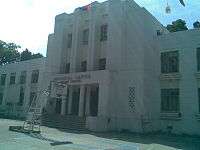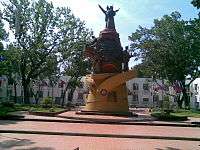Metro Cagayan de Oro
| Metro Cagayan de Oro Kadakhang Cagayan de Oro Kalakhang Cagayan de Oro | |
|---|---|
| Metropolitan Area | |
|
Aerial view of Metro Cagayan de Oro | |
| Nickname(s): Metro CDO | |
 Map of Metro Cagayan de Oro and Northern Mindanao | |
| Coordinates: PH 8°29′N 124°39′E / 8.483°N 124.650°ECoordinates: PH 8°29′N 124°39′E / 8.483°N 124.650°E | |
| Country |
|
| Region | Northern Mindanao (Region X) |
| Province |
|
| Population (2012) | |
| • Total | 1,219,224 |
| • Languages | Cebuano, Filipino (Tagalog), English |
| Time zone | PST (UTC+8) |
Metropolitan Cagayan de Oro (Filipino: Kalakhang Cagayan de Oro), also known as Metro Cagayan de Oro, is the fourth largest metropolitan area in the Philippines.[1][2] It is located on the northern coast of Mindanao, and comprises the two chartered cities of Cagayan de Oro and El Salvador and the 13 municipalities of Alubijid, Baungon, Claveria, Gitagum, Jasaan, Laguindingan, Libona, Malitbog, Manolo Fortich, Opol, Sumilao, Tagoloan, and Talakag. According to the 2007 Philippine census, Metro Cagayan de Oro has a population of 1,121,561 people.
Geography
Metro Cagayan de Oro is bounded by Macajalar Bay, which curves north. Forty percent of its area is elevated plains, located partially in Bukidnon. In the western portion the Cagayan de Oro River[3] outlines the area, which is divided by the river's tributaries from district 2 of Cagayan de Oro to Gitagum (including Laguindingan, Alubijid, El Salvador and Opol). The eastern and southern regions run from district one of Cagayan de Oro to Tagoloan to Claveria and Malitbog to Talakag, which is bordered by Bukidnon-Central Mindanao and Lanao del Norte.[4]
Metro Cagayan comprises hills, mountains and rain forests. Its biodiversity and greenery helps keep the area's temperature cool. The southern portion has semi-active volcanoes in the Kalatungan Mountain Range, although the Philippine Institute of Volcanology and Seismology (PhilVolcs) maintains that there is little risk of eruption or earthquakes.[5][6]
Climate
Under the Köppen climate classification system Cagayan de Oro has a tropical climate, with an annual average temperature of 28 °C (82 °F). In June 1998, the city recorded its highest temperature to date, 39 °C (102 °F). The city receives a varying amount of rainfall throughout the year; March and April are the driest months, and August and September the wettest. The rainy season lasts from June to November, and the drier season from December to May. The city lies outside the typhoon belt, but is affected by the Intertropical Convergence Zone.
| Climate data for Cagayan de Oro, Philippines | |||||||||||||
|---|---|---|---|---|---|---|---|---|---|---|---|---|---|
| Month | Jan | Feb | Mar | Apr | May | Jun | Jul | Aug | Sep | Oct | Nov | Dec | Year |
| Record high °C (°F) | 37 (99) |
38 (100) |
38 (100) |
38 (100) |
38 (100) |
39 (102) |
37 (99) |
37 (99) |
36 (97) |
37 (99) |
38 (100) |
37 (99) |
39 (102) |
| Average high °C (°F) | 30 (86) |
30 (86) |
31 (88) |
32 (90) |
32 (90) |
32 (90) |
31 (88) |
32 (90) |
31 (88) |
31 (88) |
31 (88) |
30 (86) |
31 (88) |
| Daily mean °C (°F) | 27 (81) |
27 (81) |
27 (81) |
28 (82) |
29 (84) |
28 (82) |
28 (82) |
28 (82) |
28 (82) |
28 (82) |
27 (81) |
27 (81) |
28 (82) |
| Average low °C (°F) | 23 (73) |
23 (73) |
23 (73) |
25 (77) |
25 (77) |
25 (77) |
24 (75) |
24 (75) |
24 (75) |
24 (75) |
24 (75) |
23 (73) |
24 (75) |
| Record low °C (°F) | 17 (63) |
17 (63) |
18 (64) |
20 (68) |
22 (72) |
18 (64) |
17 (63) |
21 (70) |
22 (72) |
18 (64) |
20 (68) |
18 (64) |
17 (63) |
| Average rainy days | 10 | 7 | 6 | 6 | 8 | 13 | 14 | 14 | 15 | 15 | 11 | 11 | 130 |
| Source: Weatherbase[7] | |||||||||||||
Government


Cagayan de Oro is the provincial capital of Misamis Oriental. The executive and judicial branches of government are based in the Misamis Oriental Provincial Capitol Building.
Metro Cagayan de Oro has the fourth-largest population in the Philippines, and is the third-largest metropolitan area geographically. Most of its cities and municipalities are located in the provinces of Misamis Oriental and Bukidnon.[8]
| Cities or municipalities | Province | Population (2015) |
Income class |
|---|---|---|---|
| Cagayan de Oro | Misamis Oriental (geographical only) | 675,950 | 1st Class City; Highly urbanized |
| |
Misamis Oriental | 50,204 | 4th Class City |
| Manolo Fortich | Bukidnon | 100,210 | 1st Class Municipality |
| Talakag | Bukidnon | 71,644 | 1st Class Municipality |
| |
Misamis Oriental | 48,906 | 1st Class Municipality |
| |
Misamis Oriental | 73,150 | 1st Class Municipality |
| Laguindingan | Misamis Oriental | 24,405 | 4th Class Municipality |
| Malitbog | Bukidnon | 24,453 | 2nd Class Municipality |
| |
Misamis Oriental | 61,503 | 2nd Class Municipality |
| Baungon | Bukidnon | 34,336 | 2nd Class Municipality |
| |
Misamis Oriental | 54,478 | 2nd Class Municipality |
| Libona | Bukidnon | 43,969 | 1st Class Municipality |
| |
Misamis Oriental | 29,724 | 4th Class Municipality |
| Sumilao | Bukidnon | 27,660 | 4th Class Municipality |
| |
Misamis Oriental | 16,373 | 5th Class Municipality |
| |
Misamis Oriental | 39,378 | 2nd Class Municipality |
Since the 1986 People Power Revolution, political power has returned to Misamis Oriental. Each city and municipality is self-governing, divided into barangays led by mayors.
Demographics
Metro Cagayan de Oro is inhabited by distinct Visayan cultural communities. Christianity (particularly Roman Catholicism) is the predominant religion. Several cultural minorities exist in central Mindanao (Talakag, Sumilao and Baungon), including the Bagobos, Subanons and Badjaos.[9] The city of Cagayan de Oro has a population of 602,088 people, making it the most-populous city in northern Mindanao.
Religion
Roman Catholicism is the predominant religion,[10][11] although Protestant denominations (including Pentecostalism and the Seventh-day Adventist Church [12] are increasing in numbers. Followers of Islam were mainly Maranao traders and immigrants.
Population
About 44 percent of households in Metro Cagayan de Oro classify themselves as Visayan (Binisaya or Bisaya), 22.15 percent as Cebuano and 4.38 percent as Boholano; 28.07 percent are from other ethnic groups, including Maranao and Bukidnon.[13] In addition to the city of Cagayan de Oro, there is rapid growth in nearby cities and municipalities (including Tagoloan and El Salvador). According to the Statistical Yearbook of the Philippines, this urban growth is a result of migration from neighboring provinces.
Cultural communities and ethnic groups living primarily in remote areas of Talakag, Baungon and Bukidnon include the Maranaws, T’boli and Bagobo. These groups have declined in population by about 12 percent since 2000 and, despite comprising 20.4 percent of the population of Mindanao, they experience discrimination in Filipino society.
Economy
Cagayan de Oro is the "melting pot of Mindanao" because of its accessibility, business growth and attractions. It is a business hub of the northern Mindanao region, with a reported income of ₱1.8 billion in fiscal year 2010. The city's economy is based on industry, commerce, trade, services and tourism. The city of Cagayan de Oro reported seven billion pesos in investment during the first six months of 2012, primarily in the service and industrial sectors. Investment in Metro Cagayan de Oro focuses on tourism, agriculture and the hospitality industry.
Healthcare
Metro Cagayan de Oro has a number of hospitals:[14]
Public
- Cagayan de Oro Medical Central
- J.R. Borja Memorial Hospital City Hospital
- German Doctors Hospital
- Northern Mindanao Medical Center
Private
- Cagayan De Oro Medical Center
- Capitol University Medical Center
- Sabal General Hospital
- Madonna and Child Hospital
- Maria Reyna Xavier University Hospital
- Orthopedic Rehab Institute
- Polymedic Medical Group
- Cagayan Polymedic General Hospital
- Cagayan Polymedic General Plaza
- Tagoloan Polymedic General Hospital
- Puerto General Hospital
Education
Education, which has the largest share (about 40 percent) of the Metro Cagayan de Oro budget, is supervised by the Northern Mindanao Region X Department of Education.[15] The 2010 census counted 203 schools in the metropolis, including six universities, 12 colleges, 52 high schools and 64 elementary and primary schools (primarily in urban areas). The student population of Metro Cagayan de Oro is estimated at 380,580.[16]
Colleges and universities in Metro Cagayan de Oro are:
Colleges
- AMA Computer University
- Cagayan de Oro College - PHINMA Education Network
- Informatics Computer Institute of Cagayan de Oro
- Lourdes College
- Pilgrim Christian College
- Systems Technology Institute
- Tagoloan Community College
- Opol Community College
- Blessed Mother College
- Southern Philippines College
- Misamis Oriental State College of Agriculture and Technology
Universities
- Capitol University
- Liceo de Cagayan University
- Mindanao University of Science and Technology
- Xavier University – Ateneo de Cagayan
Transportation
Land
Metro Cagayan de Oro is accessible by land. There are three bus and jeepney terminals with regular service: Agora Integrated Bus Terminal, Eastbound-Gusa Jeepney Terminal and Westbound-Bulua Integrated Bus and Jeepney Terminal.
Air

Lumbia Airport, also known as Cagayan de Oro Airport, hosted domestic service to Manila, Cebu, Davao and Iloilo. Manila is 75 minutes away by air, Iloilo one hour and Cebu and Davao 45 minutes. It was the second-busiest airport in Mindanao, after Francisco Bangoy International Airport in Davao City.
Laguindingan International Airport (which opened June 15, 2013, replacing Lumbia) is in the municipality of Laguindingan, Misamis Oriental. It serves northern Mindanao (including Iligan and Cagayan de Oro), offering domestic service throughout the Philippines.
Sea

Cagayan de Oro Port is an international seaport situated near the estuary of the Cagayan de Oro River. It has an anchorage depth of 18 metres (59 ft), with two cargo-handling operators. With the recent completion of the 250 million peso rehabilitation project, it is the largest seaport in Mindanao.[18] The port has regular service to Manila, Cebu, Tagbilaran, Bacolod, Dumaguete, Iloilo and Jagna.
See also
References
- ↑ Ruben G. Mercado; Casimira Balandra (October 1998). "Providing a Metropolitan Perspective to Development Planning: Cagayan de Oro" (PDF). Philippine Institute for Development Studies. Retrieved 19 August 2010.
- ↑ http://www.neda.gov.ph Building globally competitive metropolitan areas in the Philippines PDF
- ↑ Cagayan de Oro; Geography
- ↑ Metro Cagayan De Oro City, Higher grounds
- ↑ Philippines Volcanoes
- ↑ Bukidnon
- ↑ "Cagayan de Oro, Philippines: Monthly - Weather Averages Summary". Weatherbase. CantyMedia. 2016. Retrieved February 4, 2007.
- ↑ http://www.popcom.gov.ph/regions/10/Misamis%20Oriental%20Profile.htm
- ↑ Mindanao History Retrieved September 22, 2008
- ↑ TagalogLang.com:Main Religions in the Philippines
- ↑ NationMaster.com:Southeast Asia > Philippines > Religion Share
- ↑ Forum on Religion and Ecology
- ↑ Cagayan de Oro City: Population Growth Rate Declined to 1.63 Percent
- ↑ List of Hospitals in CdeO
- ↑ [National Wages and Productivity Commission: http://www.chanrobles.com/region10.wageorderno-rx-13.html WAGE ORDER NO. RX - 13: IMPLEMENTING RULES & REGULATIONS PROVIDING NEW MINIMUM WAGE RATES IN REGION X]Retrieved November 1, 2007
- ↑ Background Profile of the Philippines and the Filipino Culture
- ↑ Infrastructure of Cagayan de Oro
- ↑ P250-M rehab for Mindanao’s biggest port completed - INQUIRER.net, Philippine News for Filipinos